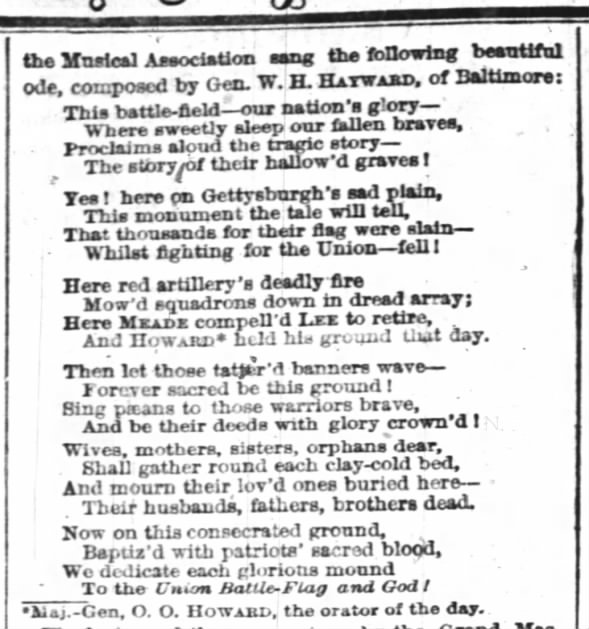The last stanza of Herman Melville's Civil War poem Gettysburg brings us to the new National Cemetery on July 4, 1865 where "Soldier and priest with hymn and prayer" had recently superintended the laying of the cornerstone for the Soldiers' National Monument.
The warrior-monument, crashed in fight,
Shall soar transfigured in loftier light,
A meaning ampler bear;
Soldier and priest with hymn and prayer
Have laid the stone, and every bone
Shall rest in honor there. -- Harper's New Monthly Magazine, July 1866.
For any reader mystified by the imagery in these closing lines, Melville's own prose note to "Gettysburg" in Battle-Pieces and Aspects of the War (New York, 1866) explains his references to the broken tombstone (of Sgt. Frederick A. Huber, as disclosed on Melvilliana) in Evergreen Cemetery, and the 1865 rites of consecration:
Among numerous head-stones or monuments on Cemetery Hill, marred or destroyed by the enemy's concentrated fire, was one, somewhat conspicuous, of a Federal officer killed before Richmond in 1862.
On the 4th of July, 1865, the Gettysburg National Cemetery, on the same height with the original burial-ground, was consecrated, and the corner-stone laid of a commemorative pile.
As previously shown on Melvilliana, Stephen H. Tyng the eminent Protestant Episcopal divine gave the formal prayer at the 1865 ceremony and thus may be seen as the model for Melville's unnamed "priest."
Numerous military officers participated in the ceremony under the direction of General John W. Geary in his official role as Chief Marshal. General Oliver O. Howard delivered the featured oration, and Colonel Charles G. Halpine aka "Private Miles O'Reilly" recited the featured poem, "Thoughts of the Place and Time." Col. Halpine's poem was printed in the July 15, 1865 issue of Harper's Weekly, accessible online courtesy of the great Internet Archive:
The eloquent prayer of Rev. Tyng was followed by two hymns--both sung by the National Union Musical Association of Baltimore--one before and one after the reading of a letter from President Andrew Johnson. The first hymn by Benjamin Brown French had been composed for the earlier Consecration of the National Cemetery at Gettysburg on November 19, 1863. The second hymn was composed by General William H. Hayward of Baltimore, known for his Camp Songs for the Soldier.
The words to General Hayward's "beautiful" Monumental Ode appeared in the New York Times of July 6, 1865:
Upon the conclusion of the reading of the letter, the Musical Association sang the following beautiful ode, composed by Gen. W. H. HAYWARD, of Baltimore:
This battle-field — our nation's glory, —Where sweetly sleep our fallen braves,Proclaims aloud the tragic story —The story of their hallow'd graves !Yes ! here on Gettysburg's sad plain,This monument the tale will tell,That thousands for their flag were slain —Whilst fighting for the Union — fell !Here red artillery's deadly fireMow'd squadrons down in dread array ;Here MEADE compell'd LEE to retire,And HOWARD held his ground that day.Then let those tatter'd banners wave —Forever sacred be this ground !Sing paeans to those warriors brave,And be their deeds with glory crown'd !Wives, mothers, sisters, orphans dear,Shall gather round each clay-cold bed,And mourn their lov'd ones buried here —Their husbands, fathers, brothers dead.Now on this consecrated ground,Baptiz'd with patriots' sacred blood,We dedicate each glorious moundTo the Union Battle-Flag and God !-- New York Times, July 6, 1865. Reprinted in the Oration of Major-General O. O. Howard (Gettysburg, 1865); and John Russell Bartlett, Soldiers' National Cemetery at Gettysburg (Providence, 1874) page 65.



No comments:
Post a Comment